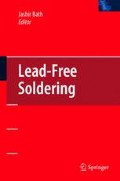Lead-free wave soldering is already in mass production in Asia and developing in Eastern Europe and the Americas, however lead-free wave is still the most challenging process to implement (together with lead-free BGA/CSP and PTH rework) and manufacturers around the world are challenged to qualify equipment and processes that will produce a quality lead-free product.
Access this chapter
Tax calculation will be finalised at checkout
Purchases are for personal use only
Preview
Unable to display preview. Download preview PDF.
References
Friedrich J (2003) Practical experience in lead-free wave soldering, ERSA GmbH
Moon K-W, Boettinger WJ, Kattner UR, Biancaniello FS, Handwerker CA (2000) Experimental and thermodynamics assessment of SnAgCu alloys, J. Electron. Mater., Vol. 29, p1122-1236
Lee N-C, Reflow soldering processes and troubleshooting SMT, BGA, CSP and Flip-Chip Technologies, Newnes, 12-253
Sweatman K (2005) Another chance for tin-copper as a lead-free solder. APEX Special Issue, p 4-7
Nimmo K (2003) Second European Lead-free Soldering Technology Roadmap, Soldertec at Tin Technology Ltd, p11-12
Seelig K (1998) A comparison of leading lead-free alloys, AIM information,Volume & Issue1, http://www.aimsolder.com/technical_articles.cfm#17
Alpha Metals, Vaculoy SACX0307, Lead-free solder wave alloy technical bulletin, US Patent 4929423
Seelig K (2005) Considerations for lead-free wave soldering AIM information, http://www.aimsolder.com/technical_articles
Morris J, O’Keefe M J (2004) Equipment impact of lead-free wave soldering, Appliance Magazine
Shea C, Barton B, Belmonte J, Kirby K (2005) Practical lead-free implementation, http://www.speedlinetech.com/docs/Practical-LF-Implementation.pdf
Couderc J-F (2005) Solectron France lead-free wave soldering internal report
Alpha Vaculoy SAC300, 305, 400, 405 Ultra low lead free wave solder alloy, Cookson Electronics, Alpha Technical bulletin
Barbini D, Wang P (2005) Implementing lead-free wave soldering iNEMI, Printed Circuit Design and Manufacture.
J-STD-002B Standard (2003) Solderability Tests for Component Leads, Terminations, Lugs, Terminals and Wires
Wang X, Poon C (2003) Benchmarking of lead-free no-clean fluxes soldering performance on OSP boards, SMTAI Conf Proceedings, Rosemont, USA
Kester VOC free flux technical bulletin
Gyemant T (2004) Lead-free wave soldering: a cost-effective alternative, SMT Articles
Wable GS, Chada S, Neal B, Fournelle RA (2005) Solidification shrinkage defects in electronic solders, Journal Of Materials, Vol. 57, no. 6, p38-42
IPC-A-610D Standard (2005) Acceptability of Electronics Assemblies
Faure C (2005) Lead-free Assembly: Process Considerations, IPC /Soldertec conference, Barcelona, Spain
Zetech (2005) Analyzing lead-free soldering defects in wave soldering using Taguchi methods, Dataweek-Electronics & Communications Technology
Bath J, Hueste G (2001) Lead-free Sn3.5Ag and Sn0.7Cu Wave Solder Evaluation with VOC-Free No-Clean and Water Soluble Fluxes, Nepcon East Conference, Boston, USA
Diepstraten G (2006) Matte or dull joints are normal and should be considered just an effect, Circuit Assembly magazine
BE95 (1994) IDEALS, BRITE-EURAM program, Synthesis report
Handwerker C (2002) NIST Research in Lead-Free Solders: Properties, Processing, Reliability, UC Smart
Havia E, Montonen H, Bernhardt E, Alatalo M (2005) Comparing SAC and SnCuNi solders in lead-free wave soldering process, NEXT Symposium, Finland.
Schouten G, Pad lifting, fillet lifting and fillet tearing issues in lead-free soldering, Vitronics-Soltec Technical White Paper
Ueshima M, Nodera M, Tajika T (2006) Mechanism of shrinkage cavities and method for restricting them in SnAgCu alloy system IPC-Soldertec conference on lead-free electronics, Malmö, Sweden
Sweatman K, Nishimura T, Jost J (2006) Solidification behaviour of the Ni-modified Sn0.7Cu eutectic, IPC-Soldertec conference on lead-free electronics, Malmö, Sweden
Handwerker CA, Noctor D, Whitten G (2000) Current assessment of the reliability of lead-free solders
Diepstraten G, The Range and Causes of Lead-Free Soldering Defects, Vitronics-Soltec Technical White Paper
Long G (2006) Lead-free surface finish overview, Intel Lead Free Symposium Sponsored by IPC, Scottsdale, Arizona, USA
Holder H, Billaut F (2006) OSP as a Pb-free surface finish at HP, Intel Lead Free Symposium Sponsored by IPC, Scottsdale, Arizona, USA
Ferrer E, Benedetto E, Freedman G, Billaut F, Holder H, Gonzalez D (2006) Reliability of Partially Filled SAC305 Through Hole Joints, IPC Printed Circuits Expo, APEX and the Designers Summit
Biocca P (2005) Lead-free reliability-building it right the first time, Kester, http://www.emsnow.com
Boone L, Campbell GP, Palacio LC (2005) Lead-free solder alloy selection: reliability is a key, SMT
Hillman D, Wilcox R (2006) JCAA/JG-PP No-Lead Solder Project:-55° C to +125°C Thermal Cycle Testing Final Report Revision B, Rockwell Collins Advanced Manufacturing Technology Group
NCMS Report 0401RE96 Pb-free Solder Project Final Report, (1997) National Center for Manufacturing Sciences
Faure C, Elkins M, Willie D, Zhou X, Lamb M, Chatterji I, Mainwaring S, Bath J Lead-free Pin Through Hole Reliability (2006), Solectron Internal Report
Author information
Authors and Affiliations
Editor information
Editors and Affiliations
Rights and permissions
Copyright information
© 2007 Springer Science+Business Media, LLC
About this chapter
Cite this chapter
Faure, C., Bath, J. (2007). Lead-Free Wave Soldering. In: Bath, J. (eds) Lead-Free Soldering. Springer, Boston, MA. https://doi.org/10.1007/978-0-387-68422-2_4
Download citation
DOI: https://doi.org/10.1007/978-0-387-68422-2_4
Publisher Name: Springer, Boston, MA
Print ISBN: 978-0-387-32466-1
Online ISBN: 978-0-387-68422-2
eBook Packages: EngineeringEngineering (R0)

